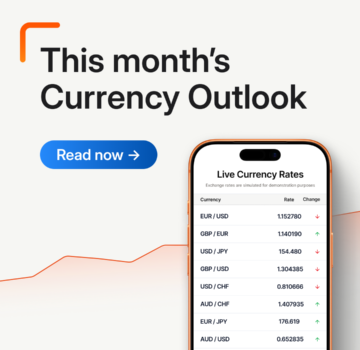Expanding into China or working with Chinese suppliers can offer major cost and production advantages. From electronics to textiles, China’s manufacturing strength makes it a go-to destination for global sourcing.
But while the opportunities are huge, sending payments to Chinese suppliers isn’t always straightforward.
International transactions involve more than just transferring funds. You need to navigate currency exchange, cross-border fees, local regulations, and banking systems that don’t always align with Western standards. A simple mistake – like a missing bank code or incorrect beneficiary name – can delay payments or even lead to failed transfers.
Choosing the right payment method is critical. China’s capital controls and strict compliance rules mean you must plan carefully to avoid delays or added fees. Foreign exchange risk, security concerns, and regulatory red tape can quickly eat into your margins if you’re not prepared. At the very least, misunderstandings or mistakes force you to waste time and effort fixing them.
A smart, well-informed payment strategy is key to keeping operations smooth and supplier relationships strong.
This guide breaks down the most efficient ways to send money to China. We’ll cover the pros and cons of each method, and share five practical tips to help you reduce costs, avoid delays, and stay compliant – so you can focus on growing your business, not chasing payments.
How to send payments to China
When paying suppliers in China, you have several different payment methods to choose from. The best option depends largely on the transaction size, urgency, and cost considerations.
Here are some of the most common ways to send business payments to China:

- 1. Bank wire transfers (SWIFT)
Most international businesses use wire transfers through the SWIFT (Society for Worldwide Interbank Financial Telecommunication) network to send payments to Chinese suppliers. This method is secure and widely accepted by Chinese banks.
But the downside is you’ll reliably face higher fees (both sender and recipient banks may charge fees) and slower processing times than some of the newer options on this list.
- Pros: Secure, widely accepted, and traceable.
- Cons: High fees, slow processing times (3–5 business days), and poor FX rates.
Foreign exchange rates in particular can trip businesses up. While you can easily factor in the slow schedules, and even high fixed banking costs, FX rates can be harder to forecast and may really eat into margins. Which is why many businesses opt for the next method.
- 2. Online international payment platforms
Businesses can use international payment providers like OFX, Convera, or PayPal, to send money to China quickly. These platforms usually offer more competitive exchange rates and lower transaction fees than traditional banks.
- Pros: Faster than wire transfers, competitive FX rates, and easier to use.
- Cons: Not all suppliers in China accept PayPal or digital wallets, and transaction limits may apply.
And in many cases, these new platforms are more user-friendly. They’re designed to send money (almost) instantly online, without some of the old-fashioned processes banks are unfortunately known for.
- 3. Foreign exchange (FX) specialists
An FX specialist can help companies save money on exchange rates and reduce hidden bank fees. FX providers offer multi-currency accounts and business-friendly transfer solutions.
- Pros: Better exchange rates, lower fees, and dedicated business solutions.
- Cons: May require additional setup and verification processes.
Because this option can take more time to set up and verify, it’s best to use a provider you trust. Ask peers and colleagues in your network for recommendations, and look closely at reviews.
- 4. Letter of Credit (LC)
A Letter of Credit (LC) is a payment method used for high-value transactions where the supplier wants payment security before shipping goods. An LC is issued by a bank and ensures that payment is only released once the supplier meets all agreed conditions.
- Pros: Secure and ensures compliance
- Cons: Lengthy processing time and high banking fees
Because of the added security, this could be a nice option when you’re working with a Chinese supplier for the first time. Especially if you’ve never met them face to face. Once you’ve established a trusting relationship, you may prefer faster, cheaper payment methods.
- 5. Cryptocurrency payments
Note: Not recommended for most transactions.
Some businesses explore cryptocurrency as a cross-border payment option. But China has strict regulations on cryptocurrency transactions, making this an unreliable method for most business payments.
- Pros: Instant transfers and low fees.
- Cons: Limited acceptance and regulatory uncertainty in China
The potential upsides are real: you can make instant transfers with low fees, and possibly avoid regulatory red tape. But for most legitimate Western businesses keen to make ongoing, reliable payments, paying by crypto in China is probably a last resort.
- 6. Cash
As with many countries, lots of Chinese vendors will happily take cash. Some may even offer discounts for it, which makes it an attractive payment method. If you can establish a physical presence on the ground in China, cash transactions might be feasible.
But in reality, they’re highly risky – maybe even on a par with crypto. You’ll have little recourse if things go wrong (such as faulty goods or failed shipments), and you still have to pay exchange fees. The costs of using a legitimate payment provider or FX specialist aren’t much higher, and the amount of protection is far better.
- Pros: Low fees and possibility of discounts
- Cons: Huge risk with very limited options if something goes wrong
We definitely wouldn’t recommend cash payments in the long term. But it’s an option in very specific circumstances.
5 common issues when paying suppliers in China
When sending money to a Chinese supplier, businesses should be mindful of several key factors. Each of these has the potential to add hidden fees, delays, or could lead to compliance issues.
- 1. Foreign exchange rates & hidden fees
As mentioned above, one of the biggest challenges businesses face when sending money to China is fluctuating exchange rates. Banks and payment providers often add a margin on top of the mid-market exchange rate, which means you could be paying more than expected.
And because FX rates are variable, they’re a hard factor to budget and forecast for. If you’re working hard to keep costs down (and your own prices competitive), you really need to keep on top of these additional costs and fees.
Tip: Always compare FX rates between banks, online payment providers, and FX specialists before making a transfer. Some providers offer forward contracts to lock in an exchange rate for future payments, which can be beneficial when you’re planning to make recurring transactions. There’s always the risk that you lock in a worse rate, but the certainty may be worth it.
- 2. China’s banking system & currency controls
You’re probably reading this guide precisely because China’s banking and financial system is different and unclear. Compared with relatively open, transparent systems in the U.K., U.S., and the E.U., China’s rules can feel inconsistent and hard to follow. Some things move very fast, while others seem impossible.
But trading with Chinese vendors is entirely achievable. The most important things to know about the banking system are:
- China has strict capital controls, so some payments require additional verification and approval.
- Suppliers may only accept certain currencies, such as USD or RMB (Chinese yuan).
Tip: Always confirm with your supplier whether they prefer payment in USD, RMB, or another currency. Some suppliers have offshore bank accounts in Hong Kong or Singapore, which may simplify transactions.
- 3. Compliance with Chinese regulations
On top of the banking system and payment processes above, there are additional regulations to consider. Again, these exist in virtually every jurisdiction, but the Chinese version may be different from what you’re used to.
Key things to note:
- Large international payments may be subject to additional scrutiny by China’s financial authorities.
- Transactions may require suppliers to provide documentation to the State Administration of Foreign Exchange (SAFE) before receiving funds.
Tip: Ensure all invoices and contracts are properly documented to avoid payment delays. Work with a local accountant or legal expert if necessary.
Most of all, make sure that the nature of the transaction and your business purposes are clear, obvious, and legitimate. If you’re not doing anything wrong, there shouldn’t be anything to worry about.
- 4. Payment delays & processing time
International payments to China can take several days to process, especially if banks or intermediaries require additional verification. Some wire transfers take 3–5 business days, and public holidays in either country can further delay processing.
Tip: Plan your payments in advance and allow for buffer time to ensure your supplier receives funds on schedule. If urgent, consider using an expedited payment service or an alternative provider with faster processing times.
- 5. Transaction security & fraud risks
Cross-border transactions are susceptible to fraud, phishing scams, and incorrect banking details. That’s not specific to China at all, but there’s always additional risk when sending payments into unfamiliar territory.
Sending money to an unknown or unverified supplier could result in lost funds or disputes. And if you don’t have a local lawyer or accountant to follow up on it, those disputes could prove very difficult.
Tip: Always verify supplier bank details and ensure that the business is legitimate before making payments. Consider using an escrow service or Letter of Credit for high-value transactions to minimise risks.
5 steps to pay Chinese vendors safely
To ensure a smooth and secure international payment process, follow this step-by-step guide when paying your Chinese supplier:

Step 1: Confirm payment details
- Verify the supplier’s full bank account details (SWIFT code, IBAN, or Chinese bank account number).
- Confirm the preferred payment denomination (USD, RMB, or another currency).
Step 2: Compare payment providers
- Research different payment options, including banks, FX specialists, and online payment platforms.
- Compare exchange rates and transaction fees before selecting a provider.
Step 3: Check compliance & documentation
- Ensure your transaction complies with Chinese foreign exchange regulations.
- Provide necessary invoices, contracts, and proof of transaction if required.
Step 4: Initiate the payment
- If using a bank wire transfer, ensure you include all required payment references.
- If using an FX provider, ensure the funds are converted at a favorable rate before sending.
Step 5: Track the payment & confirm receipt
- Monitor the transaction status and confirm with your supplier once the funds arrive.
- Retain payment receipts and transaction records for future reference.
These steps sound obvious, but it really can be that simple. Sending payments to China is much like paying international suppliers in any country. But because the payment systems and administrations are so different, it pays to be extra vigilant throughout.
Ensuring smooth and cost-effective payments to China
Sending money to China to pay a supplier can be a seamless process when approached strategically. But international transactions are inherently more complex than domestic payments thanks to issues around currency exchange, regulatory compliance, and transaction security. Without proper planning, businesses risk unnecessary fees, delays, and potential compliance issues that can disrupt supply chains and impact profitability.
To recap, make sure you’ve examined the following if you’re planning to work with Chinese suppliers:
- Bank transfer fees, and how they compare with more modern payment providers.
- Foreign exchange risks, as sudden currency movements can impact the overall cost of transactions. Consider using forward contracts to lock in exchange rates for future transactions.
- Ensuring security and compliance, particularly around fraud, cyber threats, and payment errors.
- Anti-money laundering (AML) and know-your-customer (KYC) regulations.
And to optimise cash flow, look into automation and payment tracking. A spend management platform can really streamline invoice approvals, automate recurring payments, and provide real-time visibility into business expenditures. These platforms enable finance teams to track transactions, manage foreign currency exposure, and ensure payments are made on time.
Ultimately, a well-planned approach to international payments can build strong supplier relationships, reduce transaction costs, and improve financial efficiency. Whether you’re a small business making occasional purchases or a larger company managing ongoing payments, staying informed and leveraging the right financial tools is crucial.
Headquartered in Sydney, Australia, with offices globally, in the United States, Canada, United Kingdom, Ireland, New Zealand, Singapore and Hong Kong. ISO/IEC 27001:2022 certified in Australia, 700+ employees, listed on the ASX since 2013, licensed in 50 jurisdictions and regulated by over 50 regulators globally. OFX has been a trusted innovator in global money movement for over 25 years.
Visit ofx.com/business
For businesses looking to simplify cross-border payments while reducing costs and improving efficiency, OFX’s Spend Management Platform is the perfect tool.
This article is purely for informational purposes only and should not be treated as advice. OFX will not be held liable for any losses incurred as a result of individuals or businesses relying on the information contained in this article.



